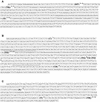Practical approach for typing strains of Leishmania infantum by microsatellite analysis
- PMID: 12202583
- PMCID: PMC130734
- DOI: 10.1128/JCM.40.9.3391-3397.2002
Practical approach for typing strains of Leishmania infantum by microsatellite analysis
Abstract
Currently the universally accepted standard procedure for characterizing and identifying strains of Leishmania is isoenzyme analysis. However, in the Mediterranean area, despite their very wide geographical distribution, most Leishmania infantum strains belong to zymodeme MON-1. In order to increase our understanding of polymorphism in strains of L. infantum, we developed PCR assays amplifying 10 microsatellites and sequenced PCR products. The discriminative power of microsatellite analysis was tested by using a panel of 50 L. infantum strains collected from patients and dogs from Spain, France, and Israel, including 32 strains belonging to zymodeme MON-1, 8 strains belonging to zymodemes MON-24, MON-29, MON-33, MON-34, or MON-80, and 10 untyped strains. Five of the microsatellites were polymorphic, revealing 22 genotypes, whereas the five remaining microsatellites were not variable. In particular, MON-1 strains could be separated into 13 different closely related genotypes. MON-33 and MON-34 strains also gave two additional genotypes closely related to MON-1, while MON-29, MON-24, and MON 80 strains exhibited more divergent genotypes. Among the foci examined, the Catalonian focus displayed a high polymorphism, probably reflecting isoenzyme polymorphism, while the Israeli focus exhibited a low polymorphism that could be consistent with the recent reemergence and rapid spread of canine leishmaniasis in northern and central Israel. The strains originating from the south of France and the Madrid, Spain, area displayed significant microsatellite polymorphism even though they were monomorphic by isoenzyme analysis. In conclusion, microsatellite polymorphism exhibits a high discriminative power and appears to be suitable for characterization of closely related strains of L. infantum in epidemiological studies.
Figures


References
-
- Baneth, G., G. Dank, E. Keren-Kornblatt, E. Sekeles, I. Adini, C. L. Eisenberger, L. F. Schnur, R. King, and C. L. Jaffe. 1998. Emergence of visceral leishmaniasis in central Israel. Am. J. Trop. Med. Hyg. 59:722-725. - PubMed
-
- Cupolillo, E., G. Grimaldi, and H. Momen. 1994. A general classification of New World Leishmania using numerical zymotaxonomy. Am. J. Trop. Med. Hyg. 50:296-311. - PubMed
-
- Felsenstein, J. 1981. Evolutionary trees from DNA sequences: a maximum likelihood approach. J. Mol. Evol. 17:368-376. - PubMed
-
- Gallego, M., F. Pratlong, R. Fisa, C. Riera, J. A. Rioux, J. P. Dedet, and M. Portus. 2001. The life-cycle of Leishmania infantum MON-77 in the Priorat (Catalonia, Spain) involves humans, dogs and sandflies; also literature review of distribution and hosts of L. infantum zymodemes in the Old World. Trans. R. Soc. Trop. Med. Hyg. 95:269-271. - PubMed
Publication types
MeSH terms
Substances
LinkOut - more resources
Full Text Sources

